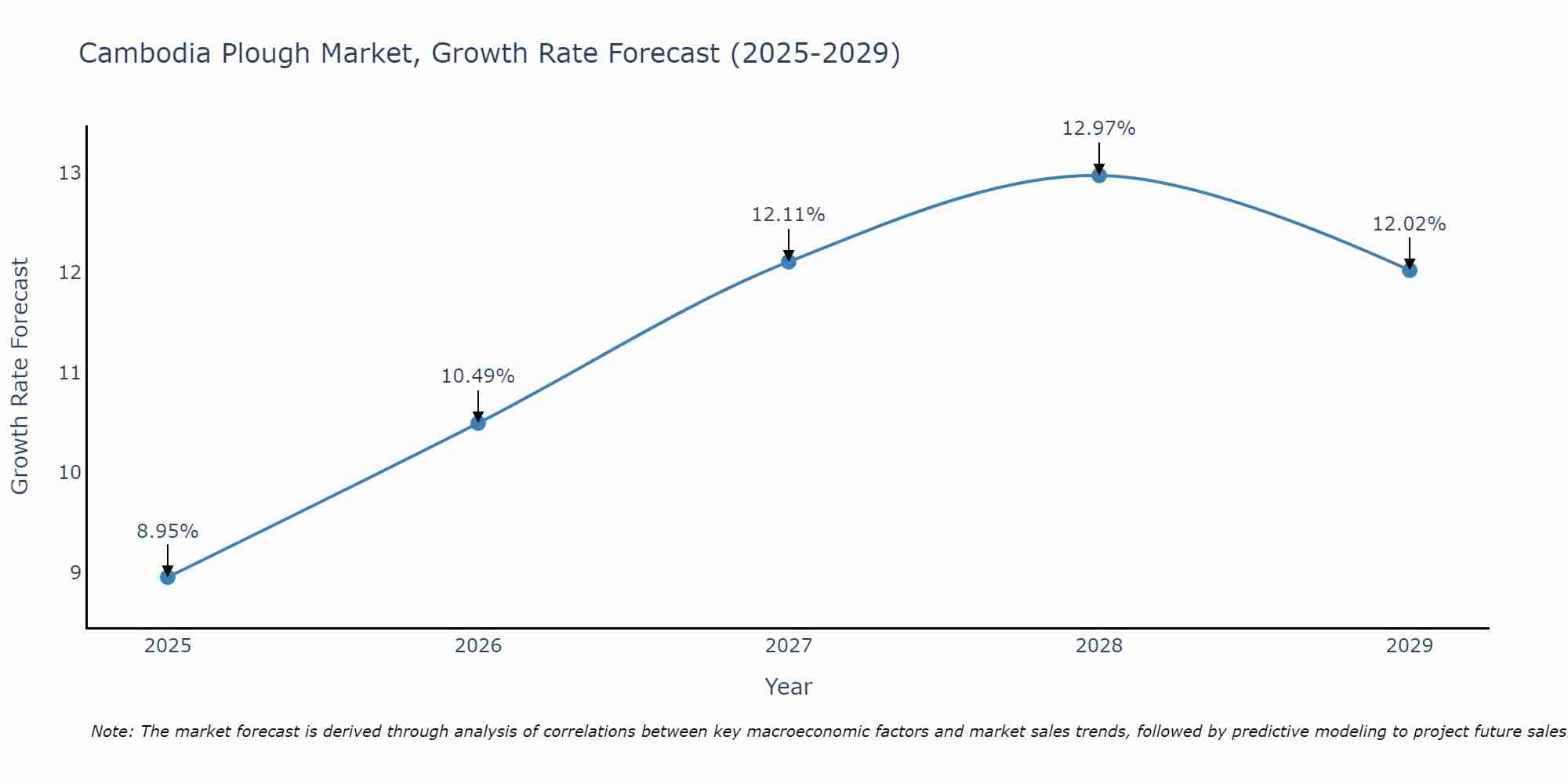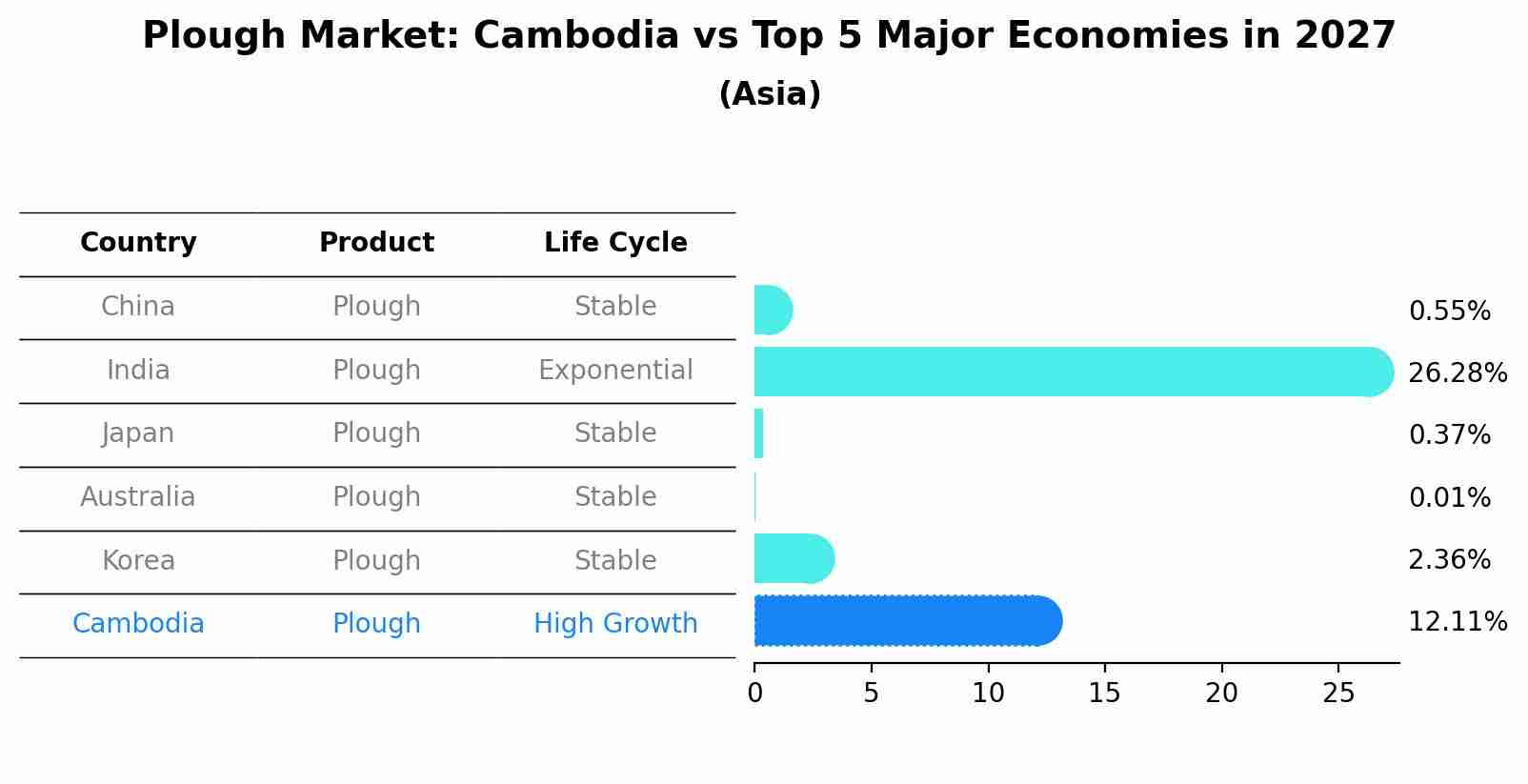Cambodia Plough Market (2025-2031) | Share, Value, Size, Industry, Growth, Forecast, Outlook, Analysis, Trends, Companies & Revenue
| Product Code: ETC051493 | Publication Date: Jan 2021 | Updated Date: Jun 2025 | Product Type: Report | |
| Publisher: 6Wresearch | Author: Ravi Bhandari | No. of Pages: 70 | No. of Figures: 35 | No. of Tables: 5 |
Cambodia Plough Market Size Growth Rate
The Cambodia Plough Market is projected to witness mixed growth rate patterns during 2025 to 2029. Growth accelerates to 12.97% in 2028, following an initial rate of 8.95%, before easing to 12.02% at the end of the period.

Plough Market: Cambodia vs Top 5 Major Economies in 2027 (Asia)
In the Asia region, the Plough market in Cambodia is projected to expand at a high growth rate of 12.11% by 2027. The largest economy is China, followed by India, Japan, Australia and South Korea.

Cambodia Plough Market Overview
The Cambodia Plough Market is a growing sector within the Cambodian agricultural industry, with a focus on the production and distribution of ploughs and related farming equipment. The market offers a range of traditional and modern plough designs to cater to the diverse needs of local farmers, including hand-held ploughs for small-scale farming and tractor-mounted ploughs for larger agricultural operations. Key players in the market include both local manufacturers and international brands, each competing to provide high-quality and cost-effective solutions to farmers. The market is driven by the increasing mechanization of agriculture in Cambodia, as well as government initiatives to promote sustainable farming practices. With a strong emphasis on improving productivity and efficiency in agriculture, the Cambodia Plough Market is expected to continue growing in the coming years.
Cambodia Plough Market Trends
The Cambodia plough market is experiencing a shift towards mechanization and modernization as farmers are increasingly adopting tractor-mounted ploughs for efficiency and productivity. This trend is driven by the government`s initiatives to promote agricultural mechanization and improve overall agricultural practices. Additionally, there is a growing demand for sustainable and eco-friendly ploughing methods, leading to the adoption of conservation agriculture practices among farmers. The market is also witnessing an increase in the availability of advanced ploughing technologies and equipment, catering to the diverse needs of farmers across different regions in Cambodia. Overall, the Cambodia plough market is evolving towards more mechanized and sustainable practices to enhance farm productivity and reduce labor-intensive traditional ploughing methods.
Cambodia Plough Market Challenges
In the Cambodia Plough Market, some of the key challenges faced include intense competition among vendors leading to price wars, lack of proper infrastructure and facilities, such as sanitation and waste management, inadequate regulation and enforcement of market rules, limited access to financial resources for small vendors to expand their businesses, and vulnerability to external factors such as weather conditions and economic fluctuations. Additionally, issues related to product quality control and counterfeit goods also pose significant challenges in the market. Addressing these challenges would require a multi-faceted approach involving collaboration between government authorities, market vendors, and relevant stakeholders to improve market conditions and support sustainable growth in the Cambodia Plough Market.
Cambodia Plough Market Investment Opportunities
Investment opportunities in the Cambodia plough market include the potential for growth due to increasing mechanization in the country`s agriculture sector, leading to a higher demand for modern ploughing equipment. Additionally, as Cambodia continues to develop its infrastructure and focus on improving agricultural productivity, there is a growing need for efficient and advanced ploughing technologies. Investors could consider opportunities in supplying high-quality ploughing equipment, offering maintenance and repair services, or investing in research and development to innovate new ploughing solutions tailored to the Cambodian market. The growing emphasis on sustainable farming practices and environmental conservation also presents opportunities for investments in eco-friendly ploughing technologies that align with Cambodia`s agricultural priorities. Overall, the Cambodia plough market offers promising prospects for investors looking to capitalize on the country`s evolving agricultural landscape.
Cambodia Plough Market Government Policy
The Cambodian government has implemented various policies to regulate the Plough Market, a popular marketplace in the country. These policies include setting guidelines for market operations, ensuring fair trade practices, and promoting consumer protection. Additionally, the government has established mechanisms to monitor and enforce compliance with these policies, such as conducting regular inspections and imposing penalties for violations. Furthermore, efforts have been made to support the growth and development of the Plough Market by providing resources and assistance to market participants, such as training programs and access to financing. Overall, the government`s policies aim to create a conducive environment for businesses to thrive in the Plough Market while safeguarding the interests of both consumers and traders.
Cambodia Plough Market Future Outlook
The Cambodia Plough Market is expected to show steady growth in the coming years due to increasing urbanization and infrastructure development in the country. The demand for ploughs is likely to rise as more farmers adopt mechanized farming techniques to increase efficiency and productivity. Additionally, government initiatives to promote modern agricultural practices and improve access to farming equipment among smallholder farmers will contribute to market growth. The market is also expected to benefit from technological advancements in plough design and manufacturing, making them more durable and efficient. Overall, the Cambodia Plough Market presents promising opportunities for manufacturers and suppliers to capitalize on the growing agricultural sector and cater to the evolving needs of farmers in the country.
Key Highlights of the Report:
- Cambodia Plough Market Outlook
- Market Size of Cambodia Plough Market, 2024
- Forecast of Cambodia Plough Market, 2031
- Historical Data and Forecast of Cambodia Plough Revenues & Volume for the Period 2021 - 2031
- Cambodia Plough Market Trend Evolution
- Cambodia Plough Market Drivers and Challenges
- Cambodia Plough Price Trends
- Cambodia Plough Porter's Five Forces
- Cambodia Plough Industry Life Cycle
- Historical Data and Forecast of Cambodia Plough Market Revenues & Volume By Types for the Period 2021 - 2031
- Historical Data and Forecast of Cambodia Plough Market Revenues & Volume By Traditional Plough for the Period 2021 - 2031
- Historical Data and Forecast of Cambodia Plough Market Revenues & Volume By Modern Plough for the Period 2021 - 2031
- Historical Data and Forecast of Cambodia Plough Market Revenues & Volume By Specialist Plough for the Period 2021 - 2031
- Historical Data and Forecast of Cambodia Plough Market Revenues & Volume By Application for the Period 2021 - 2031
- Historical Data and Forecast of Cambodia Plough Market Revenues & Volume By Farm for the Period 2021 - 2031
- Historical Data and Forecast of Cambodia Plough Market Revenues & Volume By Individual Farming for the Period 2021 - 2031
- Cambodia Plough Import Export Trade Statistics
- Market Opportunity Assessment By Types
- Market Opportunity Assessment By Application
- Cambodia Plough Top Companies Market Share
- Cambodia Plough Competitive Benchmarking By Technical and Operational Parameters
- Cambodia Plough Company Profiles
- Cambodia Plough Key Strategic Recommendations
Frequently Asked Questions About the Market Study (FAQs):
1 Executive Summary |
2 Introduction |
2.1 Key Highlights of the Report |
2.2 Report Description |
2.3 Market Scope & Segmentation |
2.4 Research Methodology |
2.5 Assumptions |
3 Cambodia Plough Market Overview |
3.1 Cambodia Country Macro Economic Indicators |
3.2 Cambodia Plough Market Revenues & Volume, 2024 & 2031F |
3.3 Cambodia Plough Market - Industry Life Cycle |
3.4 Cambodia Plough Market - Porter's Five Forces |
3.5 Cambodia Plough Market Revenues & Volume Share, By Types, 2024 & 2031F |
3.6 Cambodia Plough Market Revenues & Volume Share, By Application, 2024 & 2031F |
4 Cambodia Plough Market Dynamics |
4.1 Impact Analysis |
4.2 Market Drivers |
4.3 Market Restraints |
5 Cambodia Plough Market Trends |
6 Cambodia Plough Market, By Types |
6.1 Cambodia Plough Market, By Types |
6.1.1 Overview and Analysis |
6.1.2 Cambodia Plough Market Revenues & Volume, By Types, 2016 - 2031F |
6.1.3 Cambodia Plough Market Revenues & Volume, By Traditional Plough, 2016 - 2031F |
6.1.4 Cambodia Plough Market Revenues & Volume, By Modern Plough, 2016 - 2031F |
6.1.5 Cambodia Plough Market Revenues & Volume, By Specialist Plough, 2016 - 2031F |
6.2 Cambodia Plough Market, By Application |
6.2.1 Overview and Analysis |
6.2.2 Cambodia Plough Market Revenues & Volume, By Farm, 2016 - 2031F |
6.2.3 Cambodia Plough Market Revenues & Volume, By Individual Farming, 2016 - 2031F |
7 Cambodia Plough Market Import-Export Trade Statistics |
7.1 Cambodia Plough Market Export to Major Countries |
7.2 Cambodia Plough Market Imports from Major Countries |
8 Cambodia Plough Market Key Performance Indicators |
9 Cambodia Plough Market - Opportunity Assessment |
9.1 Cambodia Plough Market Opportunity Assessment, By Types, 2024 & 2031F |
9.2 Cambodia Plough Market Opportunity Assessment, By Application, 2024 & 2031F |
10 Cambodia Plough Market - Competitive Landscape |
10.1 Cambodia Plough Market Revenue Share, By Companies, 2024 |
10.2 Cambodia Plough Market Competitive Benchmarking, By Operating and Technical Parameters |
11 Company Profiles |
12 Recommendations |
13 Disclaimer |
- Single User License$ 1,995
- Department License$ 2,400
- Site License$ 3,120
- Global License$ 3,795
Search
Thought Leadership and Analyst Meet
Our Clients
Related Reports
- Germany Breakfast Food Market (2026-2032) | Industry, Share, Growth, Size, Companies, Value, Analysis, Revenue, Trends, Forecast & Outlook
- Australia Briquette Market (2025-2031) | Growth, Size, Revenue, Forecast, Analysis, Trends, Value, Share, Industry & Companies
- Vietnam System Integrator Market (2025-2031) | Size, Companies, Analysis, Industry, Value, Forecast, Growth, Trends, Revenue & Share
- ASEAN and Thailand Brain Health Supplements Market (2025-2031) | Strategy, Consumer Insights, Analysis, Investment Trends, Opportunities, Growth, Size, Share, Industry, Revenue, Segments, Value, Segmentation, Supply, Forecast, Restraints, Outlook, Competition, Drivers, Trends, Demand, Pricing Analysis, Competitive, Strategic Insights, Companies, Challenges
- ASEAN Bearings Market (2025-2031) | Strategy, Consumer Insights, Analysis, Investment Trends, Opportunities, Growth, Size, Share, Industry, Revenue, Segments, Value, Segmentation, Supply, Forecast, Restraints, Outlook, Competition, Drivers, Trends, Demand, Pricing Analysis, Competitive, Strategic Insights, Companies, Challenges
- Europe Flooring Market (2025-2031) | Outlook, Share, Industry, Trends, Forecast, Companies, Revenue, Size, Analysis, Growth & Value
- Saudi Arabia Manlift Market (2025-2031) | Outlook, Size, Growth, Trends, Companies, Industry, Revenue, Value, Share, Forecast & Analysis
- Uganda Excavator, Crane, and Wheel Loaders Market (2025-2031) | Strategy, Consumer Insights, Analysis, Investment Trends, Opportunities, Growth, Size, Share, Industry, Revenue, Segments, Value, Segmentation, Supply, Forecast, Restraints, Outlook, Competition, Drivers, Trends, Demand, Pricing Analysis, Competitive, Strategic Insights, Companies, Challenges
- Rwanda Excavator, Crane, and Wheel Loaders Market (2025-2031) | Strategy, Consumer Insights, Analysis, Investment Trends, Opportunities, Growth, Size, Share, Industry, Revenue, Segments, Value, Segmentation, Supply, Forecast, Restraints, Outlook, Competition, Drivers, Trends, Demand, Pricing Analysis, Competitive, Strategic Insights, Companies, Challenges
- Kenya Excavator, Crane, and Wheel Loaders Market (2025-2031) | Strategy, Consumer Insights, Analysis, Investment Trends, Opportunities, Growth, Size, Share, Industry, Revenue, Segments, Value, Segmentation, Supply, Forecast, Restraints, Outlook, Competition, Drivers, Trends, Demand, Pricing Analysis, Competitive, Strategic Insights, Companies, Challenges
Industry Events and Analyst Meet
Whitepaper
- Middle East & Africa Commercial Security Market Click here to view more.
- Middle East & Africa Fire Safety Systems & Equipment Market Click here to view more.
- GCC Drone Market Click here to view more.
- Middle East Lighting Fixture Market Click here to view more.
- GCC Physical & Perimeter Security Market Click here to view more.
6WResearch In News
- Doha a strategic location for EV manufacturing hub: IPA Qatar
- Demand for luxury TVs surging in the GCC, says Samsung
- Empowering Growth: The Thriving Journey of Bangladesh’s Cable Industry
- Demand for luxury TVs surging in the GCC, says Samsung
- Video call with a traditional healer? Once unthinkable, it’s now common in South Africa
- Intelligent Buildings To Smooth GCC’s Path To Net Zero


















